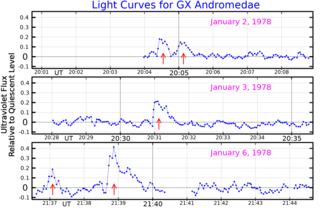
Groombridge 34 is a binary star system in the northern constellation of Andromeda. It was listed as entry number 34 in A Catalogue of Circumpolar Stars, published posthumously in 1838 by British astronomer Stephen Groombridge. Based upon parallax measurements taken by the Gaia spacecraft, the system is located about 11.6 light-years from the Sun. This positions the pair among the nearest stars to the Solar System.
Gliese 1 is a red dwarf in the constellation Sculptor, which is found in the southern celestial hemisphere. It is one of the closest stars to the Sun, at a distance of 14.2 light years. Because of its proximity to the Earth it is a frequent object of study and much is known about its physical properties and composition. However, with an apparent magnitude of about 8.6 it is too faint to be seen with the naked eye.
HD 220773 is a 7th-magnitude star approximately 165 light years away in the constellation of Pegasus.
LP 816-60 is a single red dwarf star of spectral type M4, located in constellation Capricornus at 18.6 light-years from Earth.
Ross 47 is a variable star of spectral type M4 located in the constellation Orion, 19 light-years from Earth.

Gliese 908 is a red dwarf star, located in constellation Pisces at 19.3 light-years from Earth. It is a BY Draconis variable star with a variable star designation of BR Piscium. Its apparent magnitude varies between magnitude 8.93 and magnitude 9.03 as a result of starspots and varying chromospheric activity.
Ross 695, also known as Gliese 465, is a red dwarf star in the constellation Corvus. At apparent magnitude 11.27, it is much too faint to be seen with the unaided eye. A small star, it has around 23% the mass and radius of the Sun, but only 0.7% its luminosity. Investigation of its radial velocity failed to find any evidence of a planetary companion.

GJ 357 is an M-type main sequence star with an unusually low starspot activity. It is located 31 light-years from the Solar System. The system is part of the Hydra constellation.

Gliese 15 Ac is an exoplanet orbiting the nearby red dwarf star Gliese 15 A, which is part of a binary star system located about 11.6 light-years from the Sun. The planet was first proposed in October 2017 using radial velocity data from the CARMENES spectrograph, combined with measurements from the HARPS and HIRES spectrographs, and its existence was confirmed in April 2018 using HARPS-N data. It has a minimum mass 36 times that of Earth and orbits at around 5.4 astronomical units with a period of 7,600 days, an orbit which may have been sculpted by interaction with the companion star, Gliese 15 B. As of 2020, Gliese 15 Ac is the longest-period sub-Jovian planet discovered by radial velocity.
WASP-35 is a G-type main-sequence star about 660 light-years away. The star's age cannot be well constrained, but it is probably older than the Sun. WASP-35 is similar in concentration of heavy elements compared to the Sun.
Qatar-2 is a K-type main-sequence star about 595 light-years away in the constellation of Virgo. The star is much older than Sun, and has a concentration of heavy elements similar to solar abundance. The star features a numerous and long-lived starspots, and belongs to a peculiar variety of inflated K-dwarfs with strong magnetic activity inhibiting internal convection.
WASP-52 is a K-type main-sequence star about 570 light-years away. It is older than the Sun at 10.7+1.9
−4.5 billion years, but it has a similar fraction of heavy elements. The star has prominent starspot activity, with 3% to 14% of the stellar surface covered by areas 575±150 K cooler than the rest of the photosphere.
WASP-84, also known as BD+02 2056, is a G-type main-sequence star 327 light-years away in the constellation Hydra. Its surface temperature is 5350±31 K and is slightly enriched in heavy elements compared to the Sun, with a metallicity Fe/H index of 0.05±0.02. It is rich in carbon and depleted of oxygen. WASP-84's age is probably older than the Sun at 8.5+4.1
−5.5 billion years. The star appears to have an anomalously small radius, which can be explained by the unusually high helium fraction or by it being very young.
HD 121056, also known as HIP 67851, is a K-type giant star 209 light-years away in the constellation of Centaurus. Its surface temperature is 4867±49 K. HD 121056’s concentration of heavy elements is similar to the Sun, with a metallicity Fe/H index of 0.020±0.031, although the star is enriched in lighter rock-forming elements like magnesium and aluminum.
KELT-6, also known as BD+31 2447, is a star in the constellation Coma Berenices. With an apparent magnitude of 10.34, it is impossible to see with the unaided eye, but can be seen with a powerful telescope. The star is located 791 light years away from the Solar System based on parallax, but is drifting away with a radial velocity of 1.62 km/s.
Gliese 514, also known as BD+11 2576 or HIP 65859, is a M-type main-sequence star, in the constellation Virgo 24.85 light-years away from the Sun. The proximity of Gliese 514 to the Sun was known exactly since 1988.




